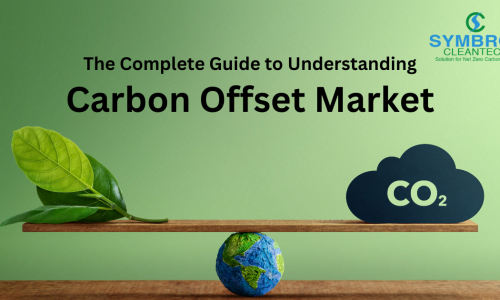Introduction to the Carbon Market
The Carbon Market, where carbon credits are bought and sold, aims to reduce greenhouse gas emissions. The companies can purchase carbon credits from companies that remove or reduce greenhouse gases from the environment and compensate for their emissions.
Table of Contents
A tonne of carbon dioxide (CO2) or the equivalent amount of another greenhouse gas avoided, sequestered, or decreased equals one trading carbon credit. A credit becomes an offset and non-tradable when it is used to cut, sequester, or prevent emissions.

The above picture is a depiction of the carbon market. Industry A emits more carbon than the credits granted by the government, whereas Industry B emits less carbon than the credits granted. ‘A’ needs more carbon credits to offset its carbon emissions. As ‘B’ has surplus credits, it can sell them in the carbon market. If ‘A’ and ‘B’ enter the carbon market, where ‘B’ sells the carbon credits to ‘A’, it would help ‘B’ gain extra income, and ‘A’ can continue its operations.
Need for Growth in the Carbon Market
Rise in Warming Levels
In 2021, the Intergovernmental Panel on Climate Change (IPCC) revealed that greenhouse gas emissions are still rising globally in all significant sectors; however, renewable energy resources have become cheaper than fossil fuels like coal. If nations do not focus on reducing greenhouse gases, a 2°C rise in warming is expected in the 21st century.
Changing Public Attitude
People’s perspectives on climate and conservation are changing. Growing consumer pressure toward sustainable environmental activities forces companies to turn to voluntary markets for carbon offsets.
By 2030, developing countries will need up to US $6 trillion to finance less than half of the climate goals, requiring high investment. The IPCC report reveals that countries fall short of funds, so arranging funds to achieve climate goals is a question.
Types of Carbon Market
Compliance
This is a cap-and-trade regulated market at regional and state levels. Each company in the market is issued a certain number of carbon credits every year and is restricted from emitting more carbon than the assigned amount.
Some companies emit less than the assigned amount, and few emit more than the assigned amount. The companies emitting less can sell the surplus credits in the regulated carbon market to the companies emitting more and looking for the credits to offset their emission.
Example: The PAT scheme is part of the compliance market. Under the scheme, from 2015 to June 2024, India saved more than 106 million tonnes of carbon emissions.
| As of December 2023, the compliance carbon market in India is still in progress. The government is currently working on it, and it is expected to become operational in 2025-26. |
Voluntary
This is the marketplace where businesses and individuals buy and sell credits according to their needs. The law does not mandate them to engage in this process to offset their carbon emissions.
Companies in the voluntary carbon market can work with environmentally conscious individuals and companies voluntarily seeking to offset their carbon emissions.
| There is no set timeline for the voluntary carbon market in India. In 2022, three Indian project developers were among the world’s top 15 carbon credit generators. Around $652 has been made by Indian organisations through the sale of carbon credits. As of May 2023, India’s voluntary carbon market is valued at $1.2 billion, registering 1,451 projects. |
A Glimpse of the Indian Carbon Market
In 2016, India joined the Paris Agreement on Climate Change and promised to keep the rise in the world’s average temperature below 2°C by the end of the century. As a part of its first Nationally Determined Contributions (NDCs), India committed to reducing its greenhouse gas emission intensity by 33-35% by 2030 from 2005. In August 2022, India updated its NDCs and increased its target to 45% from 33-35%.
To reduce the use of fossil fuels by utilising other resources such as hydrogen and biomass, India implemented a carbon market through the Energy Conservation (Amendment) Bill 2022 in response to the United Nations Climate Change Conference (COP26).
Why Does India Need A Carbon Market?
As India’s economy is continuously growing, and so is its population, there is a rise in fuel consumption. The estimated value of the carbon market in India is over 1.2 billion dollars. As of 2024, India is the second-largest carbon emitter in the world.
The carbon market aims to mitigate climate change and limit global warming to 1.5°C or lower. Businesses can minimise their carbon footprint by purchasing carbon credits to offset their emissions.
Goal: The bill aims to encourage the use of non-fossil fuel sources, which are mandatory for energy. It encourages feedstocks like green hydrogen, ammonia, biomass, and ethanol.
Current Operations of the Indian Carbon Market
As keeping the planet green is our responsibility, Hon’ble Prime Minister Narendra Modi took the Panchamrit Pledge with a target of India being carbon-neutral by 2070.
As demonstrated at COP27, India believes in ‘Common but Differentiated Responsibilities and Respective Capabilities (CBDR-RC)’ to balance its development with low carbon emissions. The government of India introduced the ‘Green Credit Program’ and ‘Mission LiFE’ to advocate a sustainable lifestyle.
The introduction of the ‘Carbon Credit Trading Scheme (CCTS), built on the Electricity Conservation Act 2001 and the Environment (Protection) Act 1986, highlighted the importance of climate finance and climate technology to focus on sustainable economic growth. CCTS is established to reduce GHG emissions by trading carbon credit certificates.
Currently, India has two market-driven programs to reduce emissions.
- Perform, Achieve and Trade (PAT) scheme: It is an instrument to reduce Specific Energy Consumption in energy-intensive groups by offering a certificate of excess energy saving that can be traded. Under PAT, the Energy Savings Certificates (ESCerts) were introduced by the Bureau of Energy Efficiency (BEE) under the National Mission of Energy Efficiency.
- Renewable Energy Certificates (REC) system: RECs are used to identify, quantify, and track the use of renewable energy sources. It is a document that authenticates and tracks the energy flowing to the power grid as renewable energy. The power company issues the REC when one-megawatt hour of renewable energy is generated and added to the power grid. It helps the stakeholders know the electricity source and how it is generated.
Benefits of Carbon Market
Financial Benefits
The companies can follow cost-effective strategies to reduce GHG emissions and achieve environmental targets. Companies can utilise low-carbon technologies and projects to reduce their carbon footprint. The companies in the carbon market can earn extra revenue by reducing their carbon emissions and selling surplus credits to needy companies.
Carbon-Neutral Environment
The carbon market supports agricultural productivity and the rural people through extra income. The market encourages adopting clean technologies, renewable energy sources, and sustainable agriculture. This is further designed to help India achieve its international climate commitments and reduce its GHG emissions by 2030.
Challenges Faced by the Carbon Market
Misleading Reduction in Carbon Emissions
Some companies prefer to buy carbon credits from the markets instead of investing in emission-reducing technologies. It has been observed that the value of Energy Saving Certificates (ESCerts) is less than the amount invested in reducing energy. This needs to be resolved to achieve the carbon-neutral goal. The government needs to plan the high cost of trading carbon credits compared to the cost of emission-reducing technologies.
Governance Framework
The government of India needs to establish a clear and transparent regulatory framework that defines rules, regulations, trading, and verification procedures. Clear guidelines for monitoring, reporting, and verifying are required for effective governance and to avoid greenwashing.
Conclusion
The carbon market plays an important role to mitigate climate change by enabling companies to trade carbon credits. The market supports the reduction of GHG emissions and boosts investments in clean technologies. In India, the carbon market needs to grow due to its rising economic growth and carbon emissions. The market faces challenges such as governance issues and misleading reductions; addressing these challenges is essential to reduce greenwashing, achieve India’s climate goals, and foster a sustainable future.
Learn more about government’s another initiative to combat climate change- Green Credit



